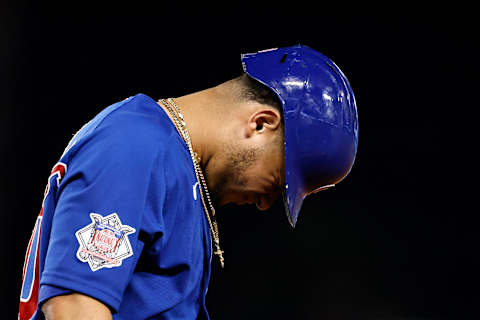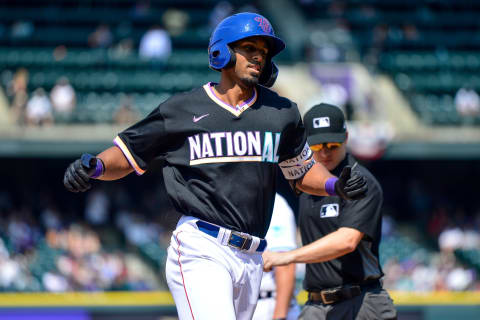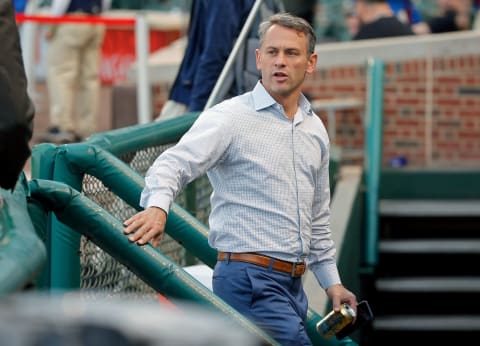Chicago Cubs: 4 reasons why 2024 is the year you should have circled


There’s no joy in Wrigleyville since the Great Trade Deadline Massacre. The Chicago Cubs have won exactly two of their last 17 games, a .117 winning percentage. That’s how a teardown and rebuild goes. All you can do is grab a cold one, sit back and embrace the suck.
However, it is fair to ask, how long will this rebuild take? Cubs owner Tom Ricketts has said the Cubs could compete in 2022. Don’t bank on it. There isn’t nearly enough MLB-ready talent in the minors. So, they’d have to spend like crazy and trade what thin talent is available to put together a championship-caliber roster. Not going to happen.
Cubs president of baseball operations Jed Hoyer has said he can’t tell how long until the team will be ready to compete. Unsatisfying as heck, but fair given the uncertainty that comes with an expiring CBA. However, there are four signs that fans can look and know when the rebuild is turning into the time to compete.
Chicago Cubs: The selloff at the MLB level
It’s not that they won’t trade at all from the MLB roster, it is for whom they trade that will change. Like from 2012-2013, in 2021 they traded core players almost exclusively for minor league talent, some of which is years from being big league-ready. Expect that same approach through the 2022 trade deadline.
You’ll also recall the Cubs moved several MLB players as late as mid-2014. Most notably, they traded Jeff Samardzija and Jason Hammel for Addison Russell, Billy McKinney and Dan Straily. Russell went to Iowa, McKinney went to Single-A ball and Straily went to the MLB roster. McKinney and Straily would later be parts of two extremely consequential trades.
Straily wound up being traded in January 2015 along with Luis Valbuena to Houston for Cubs leadoff man and Mr. ‘You Go, We Go’ himself, Dexter Fowler. Russell would come up in May 2015, and was later be part of the Cubs-loaded 2016 NL All-Star infield. McKinney progressed to Double-A before becoming part of the Aroldis Chapman trade in mid-2016.
So, when you see moves like those from 2014-2015 involving players on the MLB roster, you’ll know something is changing.

Chicago Cubs: The Iowa Cubs will be something to keep an eye on
In 2012, the year Theo Epstein and the gang rolled into town, the Iowa Cubs came in last place, posting a Pacific Coast League-worst 53-87 record and finishing 28 games out of first. By 2014, after just two seasons of restocking and drafting, they finished with a 74-70 record. That 2014 I-Cubs team spawned the core of the team that led the Cubs to their 2016 World Series title.
Today, the Iowa Cubs are again mired near the bottom of the Triple-A East Midwest Division. Pay close attention to the fortunes and the roster of this team if you want a gauge on who the new core will be and when they’ll be arriving in the Show.
Chicago Cubs: September call-ups and other roster maneuvers
For September 2021 the roster expands from 26 to just 28, down from the usual 40 spots. We’ll have to see if the new Collective Bargaining Agreement, assuming there is a new CBA, impacts this issue.
However, look for the Cubs to start rotating guys up and down from Iowa to the Windy City as they assess the talent in their system.
This has already begun with several pitchers and position players and it will happen with increasing frequency as the 2022 and 2023 seasons progress.
It’s difficult to project now who will be a part of the new core. More players will arrive via trade, others through the draft. But this is where the action will be for the next two seasons.

Chicago Cubs: Payroll is everything in today’s game
In 2011, the Cubs payroll was sixth in MLB. By 2014, it was 23rd. That’s what happens to a payroll during a teardown. In 2019, the Cubs were second in payroll and third in 2020. They were over the Competitive Balance Threshold both years, and yet they won zero postseason games. Sounds like 2011 to me.
So where to from here? I’m looking at you 2024.
The Cubs have just $44 million committed in 2022 before you add arbitration players and any signings. Who is owned most of that? Jason Heyward … $22 million of it.
More from Cubbies Crib
- Cubs: Adrian Sampson is forcing his way into the conversation
- Projecting the Chicago Cubs bullpen to open the 2023 season
- Cubs fans are beginning to see the light at the end of the tunnel
- Justin Steele has evolved into a frontline starter for the Cubs
- The future of first base is murky right now for the Cubs
So why 2024? First, the Heyward contract is off the books. Second, Hendricks, though costing far less, is also off the books by 2024, unless he is extended. Third, only two current roster players would be in their third arbitration-eligible season, Patrick Wisdom and Rafael Ortega, assuming they aren’t traded.
As it stands now, by 2024 the amount committed drops to just $5.5 million (David Bote) before arbitration and signings. The payroll will be at rock bottom.
Coinciding with this minimalist payroll, much of the talent in the minors will have percolated up to Triple-A Iowa by 2024. Of course you’ll know this because you’ve been observing to know when this rebuild will end.
One more thing about 2024. The Dodgers, Padres, Giants, Mets, Braves and Cardinals will be getting older, with payrolls bloated with declining veteran talent. The Cubs will be getting younger, with maximum payroll flexibility. All of that is why 2024 is when Chicago makes their move.
Next. Chicago Cubs History: Ranking the Theo Epstein era’s top 10 moments. dark
So, forget the MLB team for the next two years, unless beating your toes with a hammer sounds like fun. If you pay close to attention to the minors, the MLB roster additions and subtractions, and the trades, you’ll find the next winning horizon coming on faster than you’d think.